
In order to slow the trajectory of climate change, the global community must address emissions from hard-to-abate industries. For industrial decarbonization, McKinsey places a particular emphasis on four focus sectors: ammonia, cement, ethylene, and steel. The steel and cement industries represent the two largest emitting manufacturing sectors on the planet. Each sector accounts for about 8% of annual worldwide greenhouse gas (GHG) emissions—together, that’s 16% of all global emissions.
CarbiCrete’s technology replaces 100% of the cement in masonry products with steel slag, contributing to the decarbonization of both of these hard-to-abate heavy industries. The steel slag concrete is then cured using CO2, thereby sequestering emissions within the concrete for tens of thousands of years via carbon mineralization.
According to the World Economic Forum’s Net-Zero Industry Tracker, steel and cement are two of the six key industries that are responsible for 80% of industrial emissions, requiring deep decarbonization to remain feasible as the world moves toward net-zero. If efforts are not made to decarbonize, steel and cement sector emissions will grow by an untenable 31% and 43%, respectively, by 2050.
As reported by McKinsey, every tonne of steel produced in 2018 emitted on average 1.85 tonnes of carbon dioxide. Likewise, the production of cement generates CO2 emissions at a nearly 1:1 ratio. New industrial innovations like CarbiCrete technology are essential for slowing the dangerous acceleration of global climate change.
Cement, concrete’s main ingredient, only makes up about 10% of the concrete mix, yet is responsible for nearly 90% of concrete’s associated emissions. The WEF notes that “manufacturing cement creates two sources of CO₂ emissions, about 40% comes from the burning of fossil fuels to heat kilns at 1300-1450°C, and about 60% is released during the thermal decomposition of limestone into carbon dioxide and lime, an essential element of clinker which is the main ingredient of cement (about 70%).”
According to McKinsey, Carbon Capture, Utilization, and Storage (CCUS) solutions are “the only technology that can fully abate process-related CO2 emissions from cement production … they could help to decarbonize roughly 80 percent of total cement and concrete emissions by 2050.” McKinsey points to circularity as a key lever to the decarbonization of concrete, whether it be through CCUS or the utilization of recycled concrete aggregates.
In addition to emissions produced in steel’s production, the steel industry is a heavy consumer of vital resources—more than 85% of the energy used in the industry comes from fossil fuels. This generates over 350 million tonnes of steel slag per year—a byproduct destined for landfill but valorized in the CarbiCrete process. As green steel’s popularity grows, this source of viable steel slag will remain steady.
The World Economic Forum predicts that “low-emission steel is expected to reach the market by 2025 with a green premium of around 25-50% to steel buyers and below 1% to end consumers of steel products.” This green steel expansion will require international investment and public policy initiatives to encourage adjusting to green steel production methods, most notably through the integration of green hydrogen into the industry.
In a report produced by the World Steel Association on climate change and steel, maximizing scrap use and recycling is identified as one of three essential components for decarbonization. At CarbiCrete, steel slag destined for landfill is utilized in place of cement as a binder in the concrete mix. This presents multiple benefits, including the avoidance of all cement-related emissions in the concrete-making process, as well as waste valorization of an industrial byproduct.
As steel’s decarbonization advances, CCUS can be employed at steelmaking plants. This means the emissions produced in the steel manufacturing can be captured and used in additional industrial processes. For CarbiCrete, this means there is potential to utilize not only the slag produced by a steel plant, but also its CO2 emissions. This dual use of byproducts would assist in the deep decarbonization of the industry while producing a valuable product. As global decarbonization efforts target the steel and concrete industries, the expansion of CarbiCrete technology will be essential to reduce emissions, sequester carbon, and make use of waste streams.



